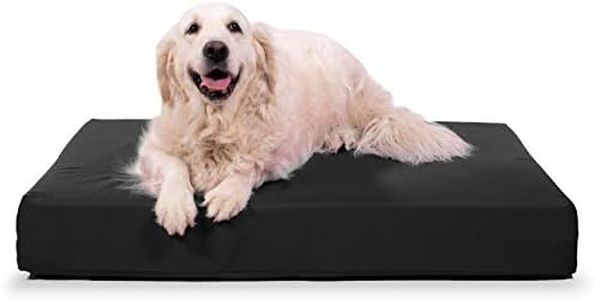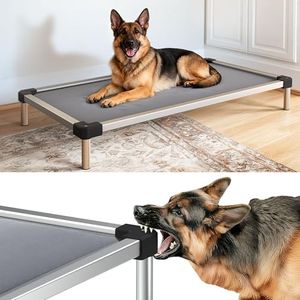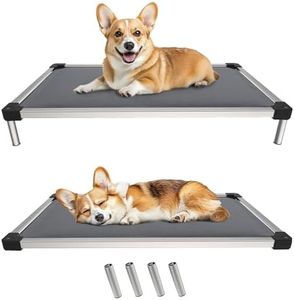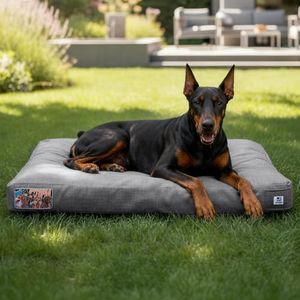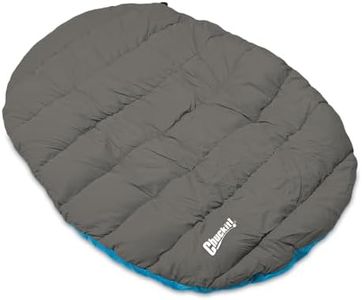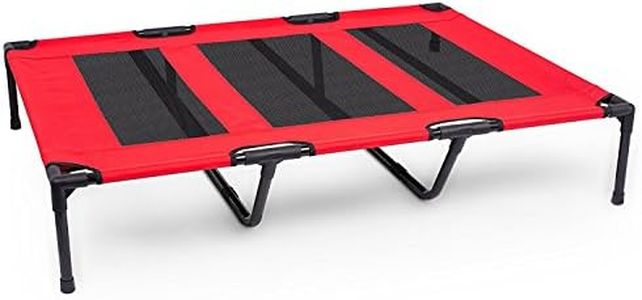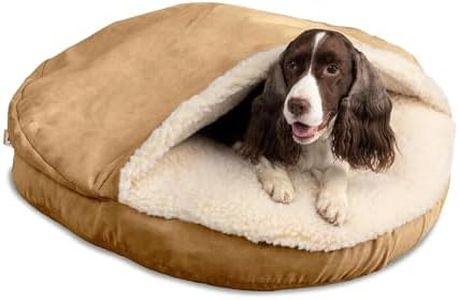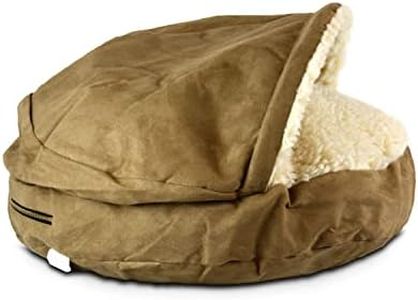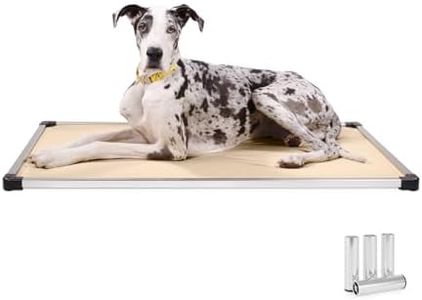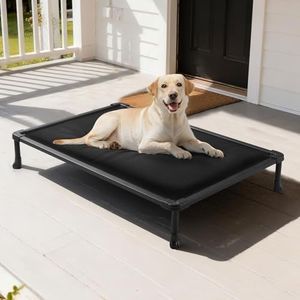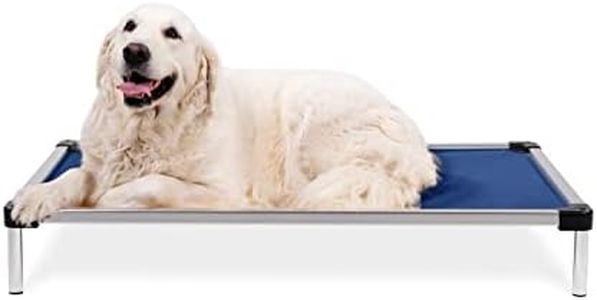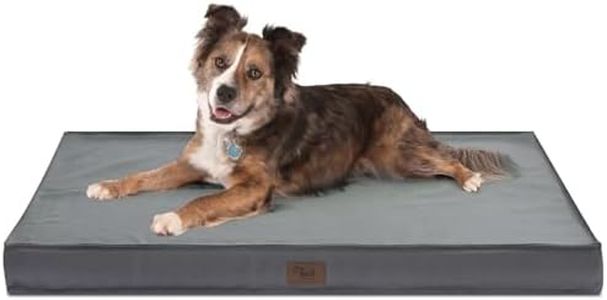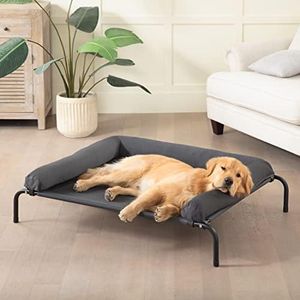10 Best Chew Resistant Dog Beds 2026 in the United States
Our technology thoroughly searches through the online shopping world, reviewing hundreds of sites. We then process and analyze this information, updating in real-time to bring you the latest top-rated products. This way, you always get the best and most current options available.

Our Top Picks
Winner
K9 Ballistics Tough Ripstop Orthopedic Rectangle Dog Bed Removable Washable Cover, Solid Orthopedic Foam for Large Dogs 40"x34", Obsidian Black
Most important from
481 reviews
The K9 Ballistics Tough Ripstop Orthopedic Dog Bed is designed for large dogs needing a durable and comfortable resting place. Its standout feature is the heavy-duty ripstop ballistic polyester cover, which resists scratching, digging, and light chewing, making it a good choice for dogs who tend to be a bit rough with their beds. However, this bed isn’t chew-proof, so dogs that chew aggressively might still damage it. The rectangular shape provides ample space for dogs to stretch out, ideal for breeds that like to spread out when sleeping.
The orthopedic solid foam mattress offers firm, supportive comfort for joints and spine, and it maintains its shape well over time, unlike softer foams that flatten. This can benefit older or larger dogs needing extra support. Cleaning is straightforward thanks to a removable, machine-washable cover that resists fur and stains, with a secure dual-closure system ensuring the cover stays in place. At 40 by 34 inches and 5 inches thick, the bed suits large dogs comfortably, and the USA-made foam adds assurance of quality.
This bed balances durability and comfort nicely, with a limitation in handling only light chewing, so it fits best for dogs who are tough but not persistent chewers. It represents a solid option for owners seeking a long-lasting, orthopedic bed that’s easy to clean and built to endure an active dog's wear and tear without heavy destructive behavior.
Most important from
481 reviews
K9 Ballistics Tough Ripstop Orthopedic Crate Bed - Durable Kennel Pad with Washable Cover for Large Dogs, 41 x 27 fits 42” Wire Crate, Obsidian Black
Most important from
713 reviews
The K9 Ballistics Tough Rip-Stop Orthopedic Dog Crate Bed is designed for durability and comfort, making it a strong contender within the chew-resistant dog bed category. The key material used is polyester with a ballistic rip-stop design, enhancing its chew resistance and durability. This material choice is ideal for dogs that tend to chew through typical beds. The construction is orthopedic, providing support for your dog's joints, which is excellent for older dogs or those with joint issues.
The bed's size, large at 41" x 27", fits well into most crates and is suitable for larger breeds. Comfort-wise, the 3-inch thickness ensures a cushy surface for dogs to rest on. The removable and washable cover adds to the ease of cleaning, which is a significant advantage for maintaining hygiene. Its water-resistant feature ensures that minor spills or accidents do not easily penetrate the bed, safeguarding its longevity. The non-skid bottom keeps the bed in place, preventing it from sliding around in the crate.
However, some users might find the bed a bit pricey. While the 10-Year Won't Flatten Guarantee and 120-Day Chew Proof Promise are reassuring, it might not be entirely indestructible for the most determined chewers. The bed's dark color, Obsidian Black, might not appeal to everyone and could show pet hair and dirt more readily. In essence, this dog bed is highly suited for pet owners looking for a durable, comfortable, and easy-to-clean solution for their larger, crate-using dogs, especially those with chewing habits.
Most important from
713 reviews
FXW TitanNest Chew-Proof Elevated Dog Bed, Raised Cot for Indoor/Outdoor/Camping Use, Durable & Washable Padded Pet Bed for Large Dogs, 50.0" L x 31.0" W x 7.3" H, Gray
Most important from
492 reviews
The FXW TitanNest Padded Dog Bed stands out as a promising choice for owners of large dogs who are known for their chewing habits. Its fully enclosed metal frame and durable 900D fabric are designed to resist chewing and scratching, making it robust and long-lasting. The custom-designed aluminum frame with reinforced ribs ensures a strong, indestructible structure that can support up to 250 lbs, which is particularly beneficial for larger breeds.
This bed is also elevated, providing comfort by keeping your dog off the ground, and it includes waterproof fabric, making it suitable for both indoor and outdoor use, including camping trips. The padded surface adds to the comfort, although the padding might not be as plush as some traditional dog beds, which could be a drawback for dogs that prefer softer surfaces. Additionally, the ease of maintenance is a highlight, as the waterproof fabric allows for simple hose-down cleaning.
However, its size could be too large for owners with limited space, and the weight of 18.21 pounds may make it less portable than lighter alternatives. This bed targets owners of dogs who need a durable, chew-resistant solution that requires minimal cleaning effort. Those looking for a long-term investment in a dog bed that prioritizes durability and ease of use will likely find this product fitting their needs well.
Most important from
492 reviews
Buying Guide for the Best Chew Resistant Dog Beds
Choosing the right chew-resistant dog bed for your furry friend is essential to ensure their comfort and safety. Dogs, especially puppies and those with a tendency to chew, can quickly destroy a regular dog bed. A chew-resistant bed is designed to withstand their chewing habits, providing a durable and long-lasting solution. When selecting a chew-resistant dog bed, consider the following key specifications to find the best fit for your dog.FAQ
Most Popular Categories Right Now
